Mango, affectionately called the king of fruits, is also the national fruit of India. It comes in different varieties. All varieties have a characteristic fruity taste. Mangoes are used across the world in numerous ways and are a good choice to grow a mango tree in your home garden. Mango trees are tropical trees and thrive well in warm climates. This article is intended to provide all the information on how to grow mango trees from seeds.
The Process
As for the majority of the seeds, mango tree seeds need a warm and humid climate to germinate. It is very easy to germinate a mango seed.
What you need?
- A fully ripe mango
- A knife
- Kitchen roll/tissue paper
- An airtight polybag/container
Step-1:
Take a ripe mango of the variety of your choice. Remove all the pulp around the seed cover.
Step-2:
Take a sharp strong knife and make a cut along the thicker side of the seed cover. Pry open the seed cover gently while making sure not to damage the seed inside. Remove the seed from inside the seed cover.
Step-3:
Take a kitchen roll/tissue paper and spread them onto a table. Sprinkle water on the tissue paper to fully moist them. Place the mango seed in the middle of the tissue paper and wrap the seed with the moist tissue paper on all the sides. Once covered, sprinkle some more water onto the top of the wrapped seed.
Step-4:
Take an airtight polybag/ziplock, place the seed inside and seal the bag so that air cannot go inside the bag. This will ensure the inside of the bag is warm and moist. Keep the bag in a dark/shaded place.
The seed will germinate in a week’s time.
Once the seedling is 6-7 inch long, transplant in the container of your choice.
Alternate Method:
Mango seeds can be germinated by putting the seeds (with soil cover intact) directly under the soil. Make sure the seed is not sown too deep inside the soil. It should be about 1 or 1.5 inches deep inside the soil so that the seed gets enough space to germinate and does not rot.
Ensure not to keep the soil too wet. Overwatering can lead to seed rotting. Keep the soil moist all the time ensuring there is no waterlogging. At the same time, the soil should not become too dry in which case the germination can no longer take place. To make the process simpler, put your index finger 1 inch deep into the soil to test the moisture level. If the soil sticks to your finger, you may skip the watering. If it does not stick and can be dusted off the finger easily, your soil needs a drink!
Please note this method of germination will be slower than the first method described here. In this method, first, the seed cover will decompose and then the seed germination will take place. Hence the germination will be 2x times slower than the first method.
The best season to germinate the seed is in August/September. Cold temperature will reduce the germination rate and hence it is recommended to choose a warm and moist climate when germinating to get the best results.
Whichever method you choose, the joy of watching the seed germinate and become a seedling is amazing!
Here is a picture of the mango tree I grew using the first method:

My first Mango Tree






May 18, 2020 at 1:56 PM
Very nice posts.
Is it possible to subscribe ? So that new posts are sent to me by email.
June 12, 2020 at 8:12 PM
Hi Vasudev, yes it is possible to subscribe. You can type your email address in the pop-up window that you see when you need this website and I will share all the latest posts with you.